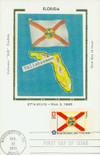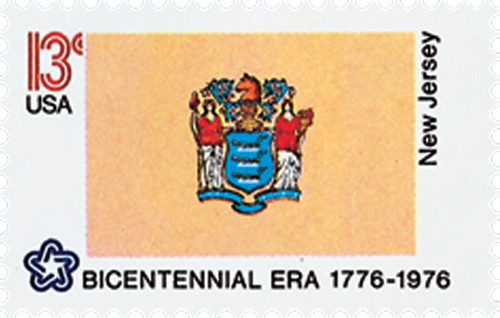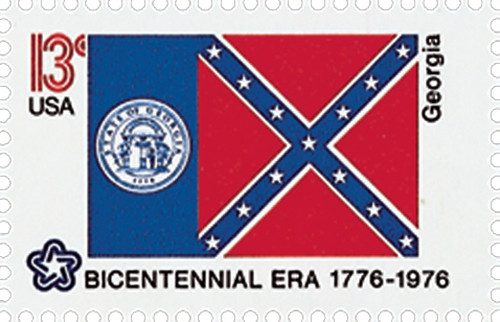
# 1659 - 1976 13c State Flags: Florida
U.S. 1659
1976 Florida
State Flags
American Bicentennial Series
• First time a sheet 50 had all different stamp designs
• Part of the American Bicentennial Series
Stamp Category: Commemorative
Series: American Bicentennial Series
Value: 13¢ First-class postage rate
First Day of Issue: February 23, 1976
First Day City(s): Washington, DC
Quantity Issued: 8,720,100 (panes of 50)
Printed by: Bureau of Engraving and Printing
Printing Method: Photogravure
Format: Sheet of 50
Perforations: 11
Why the stamp was issued:
The United States Postal Service celebrated the American Bicentennial with a full pane of the Union’s fifty state flags.
About the stamp design:
The first state flag of Florida was created in 1868. It consisted of the State Seal of Florida on a white field. At the time, the Florida State Seal contained a female Western Plains Indian scattering flowers with a steamboat, cocoa tree, and mountains in the distance.
In 1900, at the suggestion of Governor Francis P. Fleming, a red cross (known as Saint Patrick’s flag) was added behind the seal to prevent it from looking like the white flag of truce. Some 85 years later, realizing the inaccuracies of the current seal, the Florida state government changed its design. It now has a Seminole Indian woman, a sabal palm tree (the official Florida state tree), a more appropriate boat, and no mountains.
About the printing process:
Printed by the Bureau of Engraving and Printing on their seven-color Andreotti gravure press (601) which was their work horse for multicolored stamps.
About the American Bicentennial Series:
In the 1970s, America celebrated its 200th anniversary with hundreds of national events commemorating the heroes and historic events that led to our nation’s independence from Great Britain. The U.S. Postal Service issued 113 commemorative stamps over a six-year period in honor of the U.S. bicentennial, beginning with the American Revolution Bicentennial Commission Emblem stamp (U.S. #1432). As a group, the Bicentennial Series chronicles one of our nation’s most important chapters, and remembers the events and patriots who made the U.S. a world model for liberty.
Several of the stamps honored colonial life – craftsmen and communication. Other stamps honored important battles including Lexington and Concord, Bunker Hill, and Saratoga. Significant events such as the Boston Tea Party, the meeting of the First Continental Congress, and the Declaration of Independence were featured as well. The stamps also honored many significant people such as George Washington, Sybil Ludington, Salem Poor, and the Marquis de Lafayette.
Many of the stamps feature classic artwork. For instance, the set of four souvenir sheets picture important events recreated by noted artists such as John Trumbull. The Bicentennial Series also includes an important US postal first – the first 50-stamp se-tenant – featuring all 50 state flags. The format proved to be popular with collectors, and has been repeated many times since.
The American Bicentennial Series is packed with important US history – it tells the story of our nation’s fight for independence through stamps.
History the stamp represents:
On March 3, 1845, Florida joined the Union.
Scientists have dated burial mounds found along Florida’s western coast at more than 10,000 years old. There were about 350,000 Native Americans living in the Florida region when the first European explorers arrived. These Indians belonged to five main groups: the Calusa, the Tequesta, the Ais, the Timucua, and the Apalachee.
Spanish conquistador Ponce de León reached Florida in 1513 while searching for the mythical island of Bimini, said to be the site of the Fountain of Youth. Claiming the region for Spain, he named the area “La Florida,” possibly in honor of Pascua Florida, Spanish for the Easter season. In 1521, León returned to Florida to start a colony, but died from wounds he received in a battle with Indians. Pánfilo de Narváez led an expedition of 400 men to Florida in a quest to find gold, though Narváez and most of his men were killed at sea. Hernando de Soto of Spain arrived in the Tampa Bay area in 1539. He traveled beyond Florida, becoming the first European to reach the Mississippi River.
For the next 200 years, the Spanish attempted to teach the American Indians their way of life. France created colonies to the west of Florida, and Great Britain established colonies to the north. War erupted between the French and British colonists during the mid-1700s, and Spain began supporting the French. Great Britain conquered Cuba in 1762, and then traded it to Spain for control of Florida. However, British control of Florida ended during the American Revolutionary War, when Spanish forces invaded in 1781. By 1783, Spain had regained all of Florida.
By the 1800s, Florida was the only part of southeastern North America that wasn’t part of the U.S. Many Indians and runaway slaves fled from the U.S. to Florida. In 1812, settlers in Florida declared their independence from Spain, but were defeated militarily.
During the War of 1812, fought between the U.S. and Great Britain, Spain allowed Britain to use Pensacola as a naval base. American troops, led by General Andrew Jackson, seized Pensacola in 1814. Jackson entered Florida again during the First Seminole War (1817-18), and captured Fort St. Marks. Jackson also defeated the Seminole Indians. With the Adams-Onís Treaty of 1819, Spain finally turned Florida over to the United States.
Florida officially became a part of the U.S. in 1821. Jackson served as governor until 1822, when Congress organized the Territory of Florida, with William P. Duval as its first governor. Settlers from the North poured into the state. Soon, conflicts arose between these settlers and the Seminole Indians, who controlled the state’s prime farmland. The U.S. government moved many Seminole to the Indian Territory in the Oklahoma region – but some Indians refused to leave their homeland. During the Second Seminole War (1835-42), most of these Indians were killed. The Third Seminole War (1855-58) resulted in the forced relocation of most of the surviving Indians. However, a few hundred of the Seminole retreated into the swamps.
By 1839, Florida had created a constitution and was ready for statehood. However, the conflicts over slavery (Florida was a slave state) delayed its admission until March 3, 1845.
U.S. 1659
1976 Florida
State Flags
American Bicentennial Series
• First time a sheet 50 had all different stamp designs
• Part of the American Bicentennial Series
Stamp Category: Commemorative
Series: American Bicentennial Series
Value: 13¢ First-class postage rate
First Day of Issue: February 23, 1976
First Day City(s): Washington, DC
Quantity Issued: 8,720,100 (panes of 50)
Printed by: Bureau of Engraving and Printing
Printing Method: Photogravure
Format: Sheet of 50
Perforations: 11
Why the stamp was issued:
The United States Postal Service celebrated the American Bicentennial with a full pane of the Union’s fifty state flags.
About the stamp design:
The first state flag of Florida was created in 1868. It consisted of the State Seal of Florida on a white field. At the time, the Florida State Seal contained a female Western Plains Indian scattering flowers with a steamboat, cocoa tree, and mountains in the distance.
In 1900, at the suggestion of Governor Francis P. Fleming, a red cross (known as Saint Patrick’s flag) was added behind the seal to prevent it from looking like the white flag of truce. Some 85 years later, realizing the inaccuracies of the current seal, the Florida state government changed its design. It now has a Seminole Indian woman, a sabal palm tree (the official Florida state tree), a more appropriate boat, and no mountains.
About the printing process:
Printed by the Bureau of Engraving and Printing on their seven-color Andreotti gravure press (601) which was their work horse for multicolored stamps.
About the American Bicentennial Series:
In the 1970s, America celebrated its 200th anniversary with hundreds of national events commemorating the heroes and historic events that led to our nation’s independence from Great Britain. The U.S. Postal Service issued 113 commemorative stamps over a six-year period in honor of the U.S. bicentennial, beginning with the American Revolution Bicentennial Commission Emblem stamp (U.S. #1432). As a group, the Bicentennial Series chronicles one of our nation’s most important chapters, and remembers the events and patriots who made the U.S. a world model for liberty.
Several of the stamps honored colonial life – craftsmen and communication. Other stamps honored important battles including Lexington and Concord, Bunker Hill, and Saratoga. Significant events such as the Boston Tea Party, the meeting of the First Continental Congress, and the Declaration of Independence were featured as well. The stamps also honored many significant people such as George Washington, Sybil Ludington, Salem Poor, and the Marquis de Lafayette.
Many of the stamps feature classic artwork. For instance, the set of four souvenir sheets picture important events recreated by noted artists such as John Trumbull. The Bicentennial Series also includes an important US postal first – the first 50-stamp se-tenant – featuring all 50 state flags. The format proved to be popular with collectors, and has been repeated many times since.
The American Bicentennial Series is packed with important US history – it tells the story of our nation’s fight for independence through stamps.
History the stamp represents:
On March 3, 1845, Florida joined the Union.
Scientists have dated burial mounds found along Florida’s western coast at more than 10,000 years old. There were about 350,000 Native Americans living in the Florida region when the first European explorers arrived. These Indians belonged to five main groups: the Calusa, the Tequesta, the Ais, the Timucua, and the Apalachee.
Spanish conquistador Ponce de León reached Florida in 1513 while searching for the mythical island of Bimini, said to be the site of the Fountain of Youth. Claiming the region for Spain, he named the area “La Florida,” possibly in honor of Pascua Florida, Spanish for the Easter season. In 1521, León returned to Florida to start a colony, but died from wounds he received in a battle with Indians. Pánfilo de Narváez led an expedition of 400 men to Florida in a quest to find gold, though Narváez and most of his men were killed at sea. Hernando de Soto of Spain arrived in the Tampa Bay area in 1539. He traveled beyond Florida, becoming the first European to reach the Mississippi River.
For the next 200 years, the Spanish attempted to teach the American Indians their way of life. France created colonies to the west of Florida, and Great Britain established colonies to the north. War erupted between the French and British colonists during the mid-1700s, and Spain began supporting the French. Great Britain conquered Cuba in 1762, and then traded it to Spain for control of Florida. However, British control of Florida ended during the American Revolutionary War, when Spanish forces invaded in 1781. By 1783, Spain had regained all of Florida.
By the 1800s, Florida was the only part of southeastern North America that wasn’t part of the U.S. Many Indians and runaway slaves fled from the U.S. to Florida. In 1812, settlers in Florida declared their independence from Spain, but were defeated militarily.
During the War of 1812, fought between the U.S. and Great Britain, Spain allowed Britain to use Pensacola as a naval base. American troops, led by General Andrew Jackson, seized Pensacola in 1814. Jackson entered Florida again during the First Seminole War (1817-18), and captured Fort St. Marks. Jackson also defeated the Seminole Indians. With the Adams-Onís Treaty of 1819, Spain finally turned Florida over to the United States.
Florida officially became a part of the U.S. in 1821. Jackson served as governor until 1822, when Congress organized the Territory of Florida, with William P. Duval as its first governor. Settlers from the North poured into the state. Soon, conflicts arose between these settlers and the Seminole Indians, who controlled the state’s prime farmland. The U.S. government moved many Seminole to the Indian Territory in the Oklahoma region – but some Indians refused to leave their homeland. During the Second Seminole War (1835-42), most of these Indians were killed. The Third Seminole War (1855-58) resulted in the forced relocation of most of the surviving Indians. However, a few hundred of the Seminole retreated into the swamps.
By 1839, Florida had created a constitution and was ready for statehood. However, the conflicts over slavery (Florida was a slave state) delayed its admission until March 3, 1845.


















